- Home
- Colleen McCullough
The October Horse: A Novel of Caesar and Cleopatra Page 14
The October Horse: A Novel of Caesar and Cleopatra Read online
Page 14
“Yes, yes,” she said impatiently, tired of seriousness. “I have something else I want to talk about, my love.”
His eyes crinkled at their corners. “Indeed?”
“Yes, indeed. I know what we’re going to do with our two months, Caesar.”
“If the winds were with me, I’d go to Rome.”
“Well, they’re not, so we’re going to sail down Nilus to the First Cataract.” She patted her belly. “Pharaoh must show the people that she is fruitful.”
He frowned. “I agree that Pharaoh must, but I ought to stay here on Our Sea and try to keep abreast of events elsewhere.”
“I refuse to listen!” she cried. “I don’t care about events around Your Sea! You and I are setting out on Ptolemy Philopator’s barge to see the real Egypt—Egypt of Nilus!”
“I dislike being pushed, Cleopatra.”
“It’s for your health, you stupid man! Hapd’efan’e says you need a proper rest, not a continuation of duty. And what greater rest can there be than a—a cruise? Please, I beg of you, grant me this! Caesar, a woman needs memories of an idyll with her beloved! We’ve had no idyll, and while ever you think of yourself as Caesar Dictator, we can’t. Please! Please?”
4
Ptolemy Philopator, the fourth of those who bore the first name of Ptolemy, hadn’t been one of the more vigorous sovereigns of his house; he left Egypt only two tangible legacies: the two biggest ships ever built. One was seagoing and measured 426 feet in length and 60 feet in the beam. It had six banks of oars and forty men to each bank. The other was a river barge, shallower in the draft and having but two banks of oars, ten men to each oar, and measured 350 feet in length and 40 feet in the beam.
Philopator’s river barge had been put away in a ship shed on the riverbank not far above Memphis, lovingly cared for during the hundred and sixty years since its construction—wetted and oiled, polished, constantly repaired, and used whenever Pharaoh sailed the river.
The Nilus Philopator, as Cleopatra called it, contained huge rooms, baths, an arcade of columns on the deck to join the stern and bow reception rooms, one for audiences, the other for banquets. Below deck and above the oar banks were Pharaoh’s private quarters and accommodation for a multitude of servants. Cooking on board was limited to a screened-off area of braziers; the preparation of full meals was done ashore, for the great vessel cruised along at about the same speed as a marching legionary, and scores of servants followed it on the east bank; the west bank was the realm of the dead and of temples.
It was inlaid with gold, electrum, ivory, exquisite marquetry and the finest cabinet woods from all over the world, including citrus wood from the Atlas Mountains of the most wonderful grain Caesar had ever seen—no small opinion, when wealthy Romans had made the collection of citrus wood an art. Pedestals were made of chrysele-phantine—a mixture of gold and ivory—the statuary was Praxiteles, Myron, even Phidias, there were paintings by Zeuxis and Parrhasius, Pausias and Nicias, and tapestries of such richness that they vied with the paintings for reality of detail. The rugs which lay everywhere were Persian, the draperies of transparent linen dyed whatever colors were appropriate for the room.
Finally, old friend Crassus, thought Caesar, I believe your tales of the incredible wealth of Egypt. What a pity you can’t be here to see this! A ship for a god on earth.
Progress down the river was by Tyrian purple sail, for the wind in Egypt always blew from the north; then, returning, oar power was assisted by the strong river current, flowing north to Our Sea. Not that he ever saw the oarsmen, had no idea what race they were, how they were treated; oarsmen everywhere were free men with professional status, but Egypt wasn’t a place of free men. Every evening before sunset the Nilus Philopator tied up to the east bank at some royal wharf no other riverboat was allowed to contaminate.
He had thought to be bored, but he never was. River traffic was constant and colorful, hundreds of lateen-sailed dhows plying cargoes of food, goods brought overland from the Red Sea ports, great earthenware jars of pumpkin, saffron, sesame and linseed oils, boxes of dates, live animals, the floating shops of bumboats. All of it ruthlessly supervised by the swifter ships of the river police, who were everywhere.
It was easier to understand the phenomenon of the Cubits now he sailed Nilus, for the banks were seventeen feet high at their lowest, thirty-two feet high at their tallest; if the river didn’t rise higher than the lowest banks, flooding wasn’t possible, yet if it rose higher than the tallest banks, the water poured over the valley in an uncontrollable spate, washed away villages, ruined the seed grain, took far too long to recede.
The colors were dramatic, sky and river a flawless blue, the distant cliffs that denoted the beginning of the desert plateau all shades from pale straw to deep crimson; the vegetation of the valley itself was every green imaginable. At this time of year, mid-winter by the seasons, the floodwaters of the Inundation had fully receded and the crops were sprouting like sheets of lush, rippling grass, hurtling on toward the earing and harvesting of spring. Caesar had imagined that no trees grew, but saw in surprise that there were whole groves of trees, sometimes small forests—the fruiting persea, a local sycamore, black-thorn, oak, figs—and that palms of all kinds grew besides the famous date.
At about the place where the southern half of Upper Egypt became the northern half of Upper Egypt, Nilus gave off an anabranch that ran north to Lake Moeris and formed the land of Ta-she, rich enough to grow two crops of wheat and barley a year; an early Ptolemy had dug a big canal from the lake back to Nilus, so that the water continued to flow. Everything throughout the thousand-mile length of Egyptian Nilus was irrigated; Cleopatra explained that even when Nilus failed to inundate, the people of the valley could manage to feed themselves by irrigating; it was Alexandria caused the famines—three million mouths to feed, more mouths than in the whole of Nilus’s length.
The cliffs and the desert plateau were the Red Land; the valley, with its deep, dark, perpetually replenished soil, was the Black Land.
There were innumerable temples on both banks, all built on the same vast lines: a series of massive pylons connected by lintels above gateways; walls; courtyards; more pylons and gates farther in; always leading to the Holy of Holies, a small room where light was artificially guided in to appear magical, and there in it stood some beast-headed Egyptian god, or perhaps a statue of one of the great pharaohs, usually Rameses II, a famous builder. The temples were often faced with statues of a pharaoh, and the pylons were always joined by avenues of sphinxes, ram-headed, lion-headed, human-headed. All were covered in two-dimensional pictures of people, plants, animals, and painted in every color; the Egyptians loved color.
“Most of the Ptolemies have built, repaired or finished our temples,” said Cleopatra as they wandered the wonderful maze of Abydos. “Even my father Auletes built extensively—he wanted so badly to be pharaoh! You see, when Cambyses of Persia invaded Egypt five hundred years ago, he considered the temples and the pyramid tombs sacrilegious, and mutilated them, sometimes quite destroyed them. So there’s plenty of work for us Ptolemies, who were the first after the true Egyptians to care. I’ve laid the foundations of a new temple to Hathor, but I want our son to join me as its builder. He’s going to be the greatest temple builder in Egypt’s entire history.”
“Why, when the Ptolemies are so Hellenized, have they built exactly as the old Egyptians did? You even use the hieroglyphs instead of writing in Greek.”
“Probably because most of us have been Pharaoh, and certainly because the priests are so rooted in antiquity. They provide the architects, sculptors and painters, sometimes even in Alexandria. But wait until you see the temple of Isis at Philae! There we did slightly Hellenize—which is why, I think, it’s generally held to be the most beautiful temple complex in all Egypt.”
The river itself teemed with fish, including the oxyrhynchus, a thousand-pound monster which had a town named after it; the people ate fish, both fresh and smoked, as a meat stapl
e. Bass, carp and perch abounded, and much to Caesar’s amazement, dolphins streaked and gamboled, avoiding the predatory crocodiles with an almost contemptuous ease.
Many different animals were sacred, sometimes limited to a single town, sometimes universally revered. The sight of Suchis, a gigantic sacred crocodile, being force-fed honey cakes, roast meat and sweet wine had Caesar in fits of laughter. The thirty-foot-long creature was so tired of food that it would try to evade its priest feeders, to no avail; they would jack its jaws open and ram more food down while it groaned and sighed. He saw the Buchis Bull, the Apis Bull, their mothers, the temple complexes in which they lived out their pampered lives. The sacred bulls, their mothers, ibises and cats were mummified when they died, and laid to rest in vast underground tunnels and chambers. The cats and ibises were oddly sad to Caesar’s foreign eyes—little amber parceled figures by the hundreds of thousands, dry as paper, stiff, immobile, while their spirits roamed the Realm of the Dead.
In fact, thought Caesar as the Nilus Philopator drew closer and closer to the most southern regions of Upper Egypt, it is no wonder that these people have made their gods part-human and part-animal, for Nilus is its own world, and animals are perfectly fused into the human cycle. Crocodile, hippopotamus and jackal are fearsome beasts—crocodile lurks waiting to snatch an imprudent fisherman or dog or child, hippopotamus lumbers ashore to destroy food plants with its mouth and huge trotters, jackal sneaks into houses and steals babies, cats. Therefore Sobek, Taweret and Anubis are malign gods. Whereas Bastet the cat eats rats and mice, Horus the hawk does the same, Thoth the ibis eats insect pests, Hathor the cow provides meat, milk and labor, Khnum the ram sires sheep for meat, milk and wool. To Egyptians, pent up in their narrow valley and sustained only by their river, gods must naturally be as much animal as human. Here, they understand that Man too is an animal. And Amun-Ra, the sun, shines every single day of the year; to us, the moon means rain or the women’s cycle or changes of mood, whereas to them, the moon is just a part of Nut, the night sky that gave birth to the land. As for imagining their gods as we Romans do, forces that create pathways to link two different universes—no, they do not live in that kind of world. Here, it is sun, sky, river, human and animal. A cosmology containing no abstract concepts.
Fascinating to see the place where Nilus flowed out of its endless red canyon to become Egypt’s river; in sere Nubia it watered nothing, flowing between vast rock walls, said Cleopatra.
“Nilus receives two branches in Aithiopai, where he is kind again,” she explained. “These two branches collect the summer rains and are the Inundation, whereas Nilus himself flows down past Meroë and the exiled queens of the Sembritae, who once ruled in Egypt—they are so fat that they can’t walk. Nilus himself is fed by rains that fall all year round somewhere far past Meroë, which is why he doesn’t dry up in winter.”
They inspected the first Nilometer at the isle of Elephantine on the little cataract, were taken upriver to the First Cataract itself, a place of roaring white waters and precipices. Then it was on south to the wells of Syene, where on the longest day of the year the sun at noon shone right down into the wells and saw his face reflected in the water far below.
“Yes, I’ve read my Eratosthenes,” Caesar said. “Here at Syene the sun halts its northward course and starts to go south again. Eratosthenes called it the Tropic because it marked the turning point. A very remarkable man. As I remember, he blamed geometry and trigonometry on Egypt too—generations of little boys like me have wrestled their teachers and Euclid all because the Inundation obliterates the boundary stones of Egypt every single year, hence the Egyptian invention of surveying.”
“Yes, but don’t forget that it was the nosy Greeks who wrote it all down!” laughed Cleopatra, well schooled in mathematics.
* * *
The cruise was as much a discovery of Cleopatra as of Egypt. Nowhere in the world of Our Sea or the Parthians did a monarch receive the kind of absolute worship Pharaoh did as a matter of course rather than as a right or a reflex evoked by terror. The people flocked to the riverbank to throw flowers at the mighty barge sliding along, to prostrate themselves, rise and fall in one obeisance after another, to call her name. Pharaoh had blessed them with her divine presence, and the Inundation had been perfect.
Whenever she could, she would mount a dais on the deck to raise herself high enough and acknowledge her subjects very gravely, standing in profile so that they could see her pregnant belly. In every town she was sure to be there, the white crown of Upper Egypt on her head, the barge surrounded by rush canoes, little earthenware coracles and hide fishing boats, the deck sometimes awash in flowers. Though by now she was into her third trimester and not as comfortable or blooming as she had been during her second, her own needs did not matter. Pharaoh was all-important.
Despite the constant interruptions, they talked a great deal. This was a bigger pleasure for Caesar than for Cleopatra; his unwillingness to discuss just those aspects of his life she was on fire to learn about irked her, irked her, irked her. She wanted to know all the details of his relationship with Servilia (the whole world speculated about that!), his years-long marriage to a woman he had hardly cohabited with, the succession of broken-hearted women he had abandoned after he’d seduced them merely to cuckold their husbands, his political enemies. Oh, so many mysteries! Mysteries he refused to talk about, though he lectured her interminably on the art of ruling, from law to war, or would launch into fascinating stories about the Druids of Gaul, the lake temples at Tolosa and their cargo of gold a Servilius Caepio had stolen, the customs and traditions of half a hundred different peoples. As long as the subjects were not intimately personal, he was happy to talk. But the moment she started to fish in his emotional waters, he closed up.
Not unnaturally, Cleopatra left the precinct of Ptah until the end of their return journey north. Caesar had seen the pyramids from the barge, but now, mounted on a horse, he was conducted to the fields by Cha’em. Cleopatra, growing very heavy, declined to go.
“Cambyses of Persia tried to deface the outer polished stones, but became bored by chipping away and concentrated his destruction on temples,” said Cha’em, “which is why so many of them are almost pristine.”
“For the life of me, Cha’em, I cannot understand why a living man, even one who was a god, would devote so much time and toil to a structure of no use to him during life,” Caesar said, genuinely puzzled.
“Well,” Cha’em answered, smiling subtly, “you must remember that Khufu and the rest didn’t do the actual work. Perhaps they came occasionally to see progress, but it never went further than that. And the builders were very skilled. There are about two million large stones in Khufu’s mer, but most of the construction was done during the Inundation, when barges could bring the blocks to the bottom of the ramps up on to the plateau, and labor was not required in the fields. During planting and harvesting seasons, large-scale work virtually stopped. The polished outer casing is limestone, but once the top of each mer was sheathed in gold—plundered, alas, by the foreign dynasties. The tombs inside were broken into at the same period, so all the treasures are gone.”
“Where then is the treasure of the living Pharaoh?”
“Would you like to see it?”
“Very much.” Caesar hesitated, then spoke. “You must understand, Cha’em, that I am not here to loot Egypt. Whatever Egypt has will go to my son—or to my daughter, for that matter.” He hunched his shoulders. “I can’t be happy at the thought that in time to come my son might marry my daughter—incest is anathema to Romans. Though, oddly enough, I notice from overhearing what my soldiers say that Egypt’s so-called beast gods upset them more than incest does.”
“But you yourself understand our ‘beast gods’—I see it in your eyes.” Cha’em turned his donkey. “Now to the vaults.”
Rameses II had built much of the half-square-mile of Ptah’s precinct, approached through a long avenue of magnificent ram-headed sphinxes, and had flanked
its west pylons with colossal statues of himself, meticulously painted.
No one, Caesar decided, even he, would ever have found the entrance to the treasure vaults without prior knowledge. Cha’em led him through a series of passageways to an interior room where painted, life-size statues of the Triad of Memphis stood in ghostly illumination. Ptah the Creator himself stood in the middle, shaven-headed, with a real skullcap of worked gold fitted tightly on his cranium. He was wrapped in mummy bandages from feet to neck save that his hands protruded to hold a staff on which were a terraced pillar, a large bronze ankh—a T-shaped object surmounted by a loop—and the crook of a scepter. To his right was his wife, Sekhmet, who had the body of a well-shaped woman but the head of a nemes-maned lion, with the disc of Ra and the cobra uraeus above the mane. On Ptah’s left was their son, Nefertem, Guardian of the Two Ladies and Lord of the Lotus, a man wearing a tall blue lotus crown flanked on either side by a plume of white ostrich feathers.
Cha’em tugged at Ptah’s staff and detached the ankh with the crook atop it, handed the very heavy object to Caesar, then turned and left the chamber to retrace the path from the outer pylons. On a nondescript section of corridor he stopped, knelt down and pushed with both palms on a cartouche just above the level of the floor; it sprang forward just enough for Cha’em to lever it free of the wall. Then he extended one hand and took the ankh from Caesar, inserted its blunt end into the space.
“We thought about this for a very long time,” he said as he began to wind the ankh back and forth, using the crook on its end to apply considerable force. “Tomb robbers know all the tricks, so how to fool them? In the end we settled for a simple device and a subtle location. If you count all the corridors, they amount to many, many cubits. And this is just another corridor.” He grunted with the effort, his words suddenly almost drowned by a groaning grinding. “The story of Rameses the Great unfolds along each wall, the cartouches of his many sons among the hieroglyphs and pictures. And the paving—why, it is like all the other paving.”

 The October Horse: A Novel of Caesar and Cleopatra
The October Horse: A Novel of Caesar and Cleopatra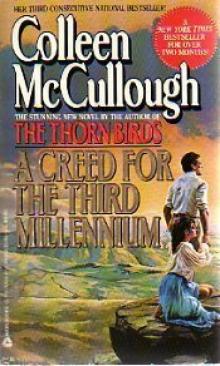 A Creed for the Third Millennium
A Creed for the Third Millennium An Indecent Obsession
An Indecent Obsession The Thorn Birds
The Thorn Birds Morgan's Run
Morgan's Run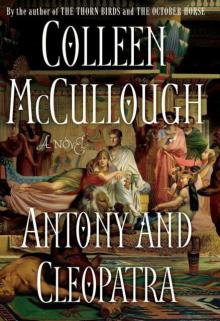 Antony and Cleopatra
Antony and Cleopatra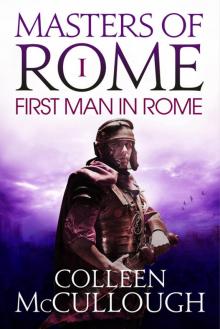 The First Man in Rome
The First Man in Rome Caesar
Caesar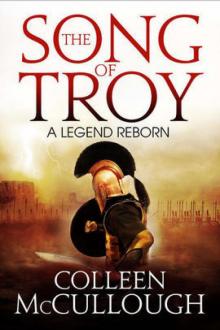 The Song of Troy
The Song of Troy Fortune's Favorites
Fortune's Favorites The Touch
The Touch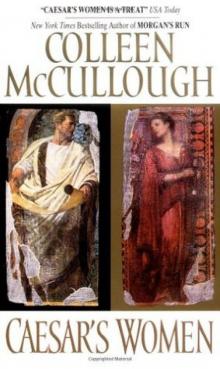 Caesar's Women
Caesar's Women The Independence of Miss Mary Bennet
The Independence of Miss Mary Bennet The Grass Crown
The Grass Crown Tim
Tim Bittersweet
Bittersweet Angel
Angel 3. Fortune's Favorites
3. Fortune's Favorites Sins of the Flesh
Sins of the Flesh 2. The Grass Crown
2. The Grass Crown Life Without The Boring Bits
Life Without The Boring Bits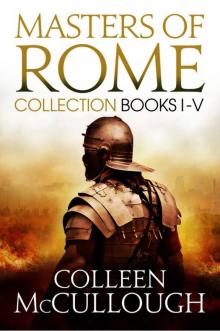 Masters of Rome Boxset: First Man in Rome, the Grass Crown, Fortune's Favourites, Caesar's Women, Caesar
Masters of Rome Boxset: First Man in Rome, the Grass Crown, Fortune's Favourites, Caesar's Women, Caesar Too Many Murders
Too Many Murders 1. First Man in Rome
1. First Man in Rome On, Off
On, Off 5. Caesar
5. Caesar Naked Cruelty
Naked Cruelty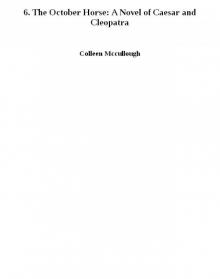 6. The October Horse: A Novel of Caesar and Cleopatra
6. The October Horse: A Novel of Caesar and Cleopatra